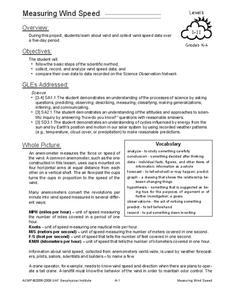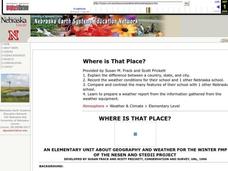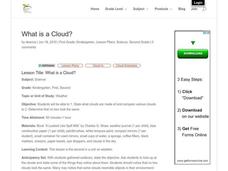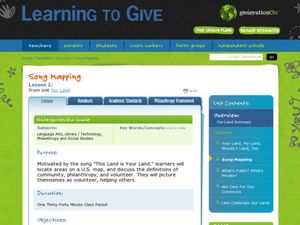Hawaiʻi State Department of Education
Cloud Sculpting
Dance is a fantastic way to communicate thoughts, feelings, and even science concepts. Make this activity a part of your next unit on weather and clouds. Kids will discuss types of clouds, how they look, and what they do. Then, they will...
University of Wisconsin
A Rain Garden Year
Pupils become plants in an interpretive play that depicts what happens throughout the seasons in a rain garden. As you narrate, young scholars bloom, flower, and go to seed accordingly. The instructional activity is first in a series of...
Curated OER
Measuring Wind Speed
Young scholars study wind speed and collect wind speed data. In this wind speed lesson, students visit a website to learn about the local wind speed forecast for their week. Young scholars discuss wind and wind speed. Students collect...
Curated OER
Where Is That Place?
Learners choose a school in their state to compare their weather to. They also describe the differences between country, state, and a city. They can make flashcards to help them remember the important terms and concepts.
Curated OER
Cloudy with a Chance of Meatballs
Learners read about weather and create a computer log about weather. In this Cloudy with a Chance of Meatballs lesson, students listen to the story and discuss different weather patterns. Learners develop a list of weather...
Curated OER
What's the Weather Forecast?
Students create a radio announcement based on the book Cloudy with a Chance of Meatballs. In this radio announcement lesson plan, students discuss the type of language used in other announcements and create their own.
Curated OER
Thematic Unit on Cats
Students discover in which climates the cats of the world live in. They review the different climates of the world and use maps and globes to help them locate continents.
Curated OER
Winter Carnival!
Students research about outdoor winter activities that include sports and the arts. They gather information about weather conditions and winter carnivals in Canada and the United States. Each student then visually depicts their findings...
Curated OER
Seasoning the School Year
Students observe the changes a class tree goes through as the seasons change and record observations in journals. They investigate changes in the weather, changes in the length of the day, and how that affects people. They create...
Curated OER
What is a Cloud?
Students identify what clouds are made of. In this weather science lesson, students look at clouds outside the window and draw what they see in their journals. Students read the book It Looked Like Spilled Milk and identify what clouds...
Curated OER
What is Soil?
Young scholars examine soil. For this earth science lesson, students define and describe weathering and erosion as it relates to soil. Young scholars compare and contrast potting soil with forest soil and complete a science observation...
Curated OER
Boston Harbor Cruise: A Shoreline Survey
The students take a harbor cruise, photograph, and draw shore line features attending to evidence of human impact/consequences, and its cost on marine/land animal habitats vegetation, weather patterns, signs of erosion, and the water...
Curated OER
Around the World
Young scholars discuss the major geographical and cultural differences in the world. In this social science lesson, students pretend they are traveling and research information about where they wish to stay by finding information about...
Curated OER
Seasons Culminating Activity
Students develop a PowerPoint presentation as the culminating project in a unit on seasons. They complete a KWL chart, conduct Internet research, take an online quiz, and create a PowerPoint presentation using text, video clips, and...
Curated OER
Make a Model of a Tree
Students identify the parts of a tree. In this tree biology lesson, students create a tree model using tree parts and drawing the roots. Students label each part of the tree and maintain a tree journal during this unit.
Curated OER
The Mystery of the Missing Hummingbirds
Students record scientific observations in a science journal. In this season lesson plan, students make observations about each of the seasons and record in their journals. Students record organisms response to seasonal...
Curated OER
Temperature
Students understand that temperatures in Alaska can be negative numbers. In this temperature lesson, students recognize the temperatures above and below zero. Students compare temperatures using the greater than and less than signs....
Curated OER
Mexico
Students complete a unit about the geography and culture of Mexico. They compare and contrast the weather of their own city and Mexico, read books about Mexico, count in Spanish, color in a flag of Mexico and the Mexican Coat of Arms,...
Curated OER
Song Mapping
Young scholars explore locations on the United States map. In this map skills lesson, students recite the song This Land Is Your Land and locate various places listed in the song on the map.
Curated OER
Papier-Mâché Globe
Paper mache projects are great for using up paper from the recycle bin. Give your class the chance to create a three-dimensional globe out of paper mache. They'll work to make their globes as accurate as possible, adding proper colors...
National Park Service
Living & Non-Living Interactions
What better way to learn about ecosystems than by getting outside and observing them first hand? Accompanying a field trip to a local park or outdoor space, this series of collaborative activities engages children in...
University of Texas
Observing the Moon
Why does it look like there is a man on the moon? Why does the moon look different every night? These are the focus questions of a lesson that prompts class members to observe and record the nightly changes of Earth's natural...
Skyscraper Museum
Building a Skyscraper
Creating buildings that reach hundreds of feet into the sky is no easy task. The third instructional activity in this series begins with four activities that engage young architects in exploring the major challenges that are faced when...
K5 Learning
The Moon
Second graders read a short informational text passage about the moon and answer a series of questions based on what they read.























